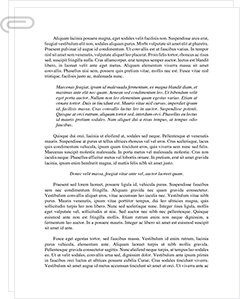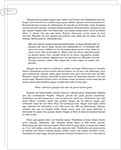 Study Document
Study Document
Criminal Behavior Linked to Corporal Punishment Research Paper
Pages:4 (1292 words)
Sources:3
Document Type:Research Paper
Document:#11822799
Does Corporal Punishment Increase the Likelihood of Criminal Activity?NameInstitutionDateDoes Corporal Punishment Increase the Likelihood of Criminal Activity?Corporal punishment, is the use of physical force to inflict pain as a means of discipline, has been a topic of significant debate in child-rearing practices and educational settings. The central question is whether such practices contribute to a higher likelihood of criminal behavior later in life. The relationship between disciplinary methods in childhood and later criminal behavior is complex and multifaceted, involving psychological, sociological, and cultural factors. This paper analyzes both sides of the argument, reviewing recent empirical research and theoretical perspectives to present a balanced view. By examining the available evidence, we seek to present a thorough analysis of the latest research on this critical issue in social psychology and criminology.BackgroundThe debate over corporal punishment has a long history in child development and criminology research. Early studies in the 20th century often focused on the immediate effectiveness of physical discipline in controlling child behavior. However, as longitudinal research methods improved, attention shifted to the long-term consequences of corporal punishment, including potential links to criminal behavior.For this paper, we define corporal punishment as any physical force used to cause pain or discomfort for disciplinary purposes. This can range from spanking to more severe forms of physical punishment. Criminal activity is behavior that violates criminal law and is subject to legal sanctions.The significance of this debate extends beyond academic circles. It has profound implications for parenting practices, educational policies, and legal frameworks surrounding child discipline. Understanding the potential link between corporal punishment and criminal activity is crucial for developing effective strategies to reduce crime and promote positive child development.Arguments Supporting a Link Between Corporal Punishment and Criminal ActivityRecent studies continue to support the notion that corporal punishment may increase the likelihood of criminal activity later in life. These arguments are primarily based on physical discipline\'s psychological and behavioral effects on children. A study by Medeiros et al. (2023) found that parents who experienced corporal punishment as children were more likely to use it on their children, perpetuating a cycle of violence. This intergenerational transmission of harsh discipline may increase the risk of aggressive and antisocial behaviors, potentially leading to criminal activity.The impact of corporal punishment extends beyond behavioral patterns to affect neurological development. Recent neuroimaging studies have shown that harsh physical punishment can alter brain structure and function. Research by Cuartas (2023) found that children who experienced corporal punishment had altered neural responses to perceived threats, which could affect their decision-making processes and impulse control factors often associated with criminal behavior. These findings…
…underlying factors rather than a direct causal relationship. Furthermore, recent research by Gawali and Bedi (2019) stresses the importance of considering the broader context in which corporal punishment occurs. Factors such as parental warmth, explanation of rules, and consistency in the discipline may moderate the effects of physical punishment on child outcomes, including potential criminal behavior.ConclusionWhether corporal punishment increases the likelihood of criminal activity has no simple, definitive answer. The most recent research on this topic presents a complex picture, with evidence supporting both sides. However, the weight of evidence continues to lean towards a connection between corporal punishment and increased risk of negative outcomes, including aggressive and antisocial behaviors that may be precursors to criminal activity.While a direct causal link between corporal punishment and criminal behavior remains challenging to establish conclusively, the potential risks associated with physical discipline are significant enough to warrant caution. The neurological, psychological, and social learning effects of corporal punishment provide compelling reasons to consider alternative disciplinary methods that can effectively guide children\'s behavior without the potential negative consequences.As research in this field evolves, parents, educators, and policymakers must stay informed about the latest findings and recommendations. Ultimately, the goal should be to promote disciplinary practices that support positive child development, strong family relationships, and the cultivation of prosocial behaviors that cut…
Related Documents
 Study Document
Study Document
Corporal Punishment As It Is
Not all children will respond to positive reinforcement, but sometimes even drastic negative reinforcement such as corporal punishment does not work on these children. In general, however, positive reinforcement is only one way to teach children discipline very quickly and make sure that the lesson remains with them in the future. In the past, it was thought that corporal punishment was the way to do this, and some schools
 Study Document
Study Document
History of Punishment Critically Assess
Too little, for what matters is that he knows he is being watched and too much, because he has no need in fact of being so (Alford, 2000). Bentham laid down the principle that power should be visible and unverifiable. Visible in that the inmate would constantly have before him the tall outline of the central tower from which he was watched. Unverifiable in that the inmate must never know
 Study Document
Study Document
History and Evolution of Probation and Classification Supervision Techniques...
Probation originated from ancient times in England and the United States, it was devised so that they could avoid the mechanical application of the harsh penal codes of the day. Early criminal law of the British that was practicing much of the objectives of retribution as well as punishment imposed on the offenders severe and rigid penalties. The punishment which was common was corporal such as flogging, branding, mutilation and
 Study Document
Study Document
Family Deliquency and Crime Nowadays
"While biological and psychological factors hold their own merit when explaining crime and delinquency, perhaps social factors can best explain juvenile delinquency" which "is a massive and growing problem in America." (http://www.skidmore.edu/academics/english/courses/en205d/student7/stud7proj2.html) Reference: Doggett, a. "Juvenile Delinquency and Family Structure" http://facstaff.elon.edu/ajones5/Anika's%20paper.htm Goode: 1994, 1997, 2001, 2005; and Pfohl, Images of Deviance and Social Control, 1985. Social Disorganization at the micro level: Control Theories: Why most don't deviate?" Owner: Robert O. Keel. Last Updated: Monday, October
 Study Document
Study Document
Families, Delinquency & Crime What
If the child is punished for small infractions of the rules and other children are not, this makes him feel that life is unfair, and makes him act in the ways that he is expected to act. Formal labeling is manifest when teachers treat students labeled as gifted as brighter, which motivates the children to perform better on tests, or when students labeled as 'special education' or 'ESL' are
 Study Document
Study Document
Child Abuse Many Parents Believe
These findings are consistent with those reported in studies of children older than 2 years but extend these findings to children who are spanked beginning at a relatively early age (Wissow Pp). In the January 2002 issue of "Journal of Counseling and Development," Lisa Fontes states that Latino parents who engage in harsh physical discipline need help, however, they are far from homogeneous and their needs vary (Fontes Pp). She




